Menu
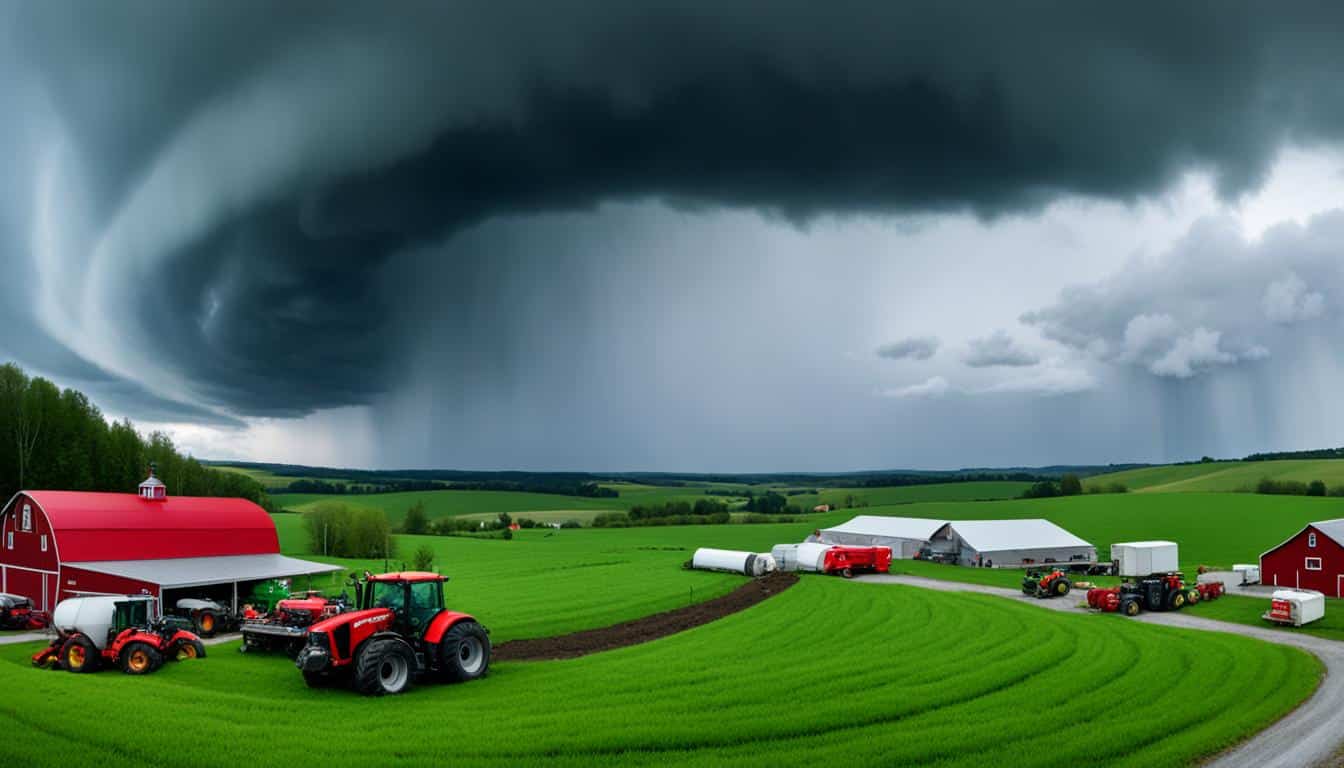
Did you know that farm emergencies, like severe weather or equipment accidents, can happen suddenly? It’s vital to be prepared for these moments with strong farm emergency communication strategies. Having a clear plan in place is key for any farm. This includes making sure everyone who could help knows what to do. This means family, employees, and local emergency services like the sheriff, fire department, and ambulance service must work together. Being ready helps everyone act fast when needed.
Every farm should get ready for emergencies because farm life is full of surprises. This is vital as things like tornadoes, floods, and fires can show up without warning. They put both people and property at risk.
Having a plan for when things go wrong is key on a farm. An Emergency Action Plan, or EAP, should lay out how to escape, where to meet, and who to call. It makes sure everyone knows what to do, be they family or workers, when an emergency hits.
Farm life’s ups and downs need a detailed response plan. This should include plans for leaving and staying put. It also factors in having power backups, safety kits, and what to do if you can’t get out.
Everyone on the farm should help make and know the emergency plans. This boosts readiness and could save lives by making sure plans are seen by all.
| Component | Description |
|---|---|
| Emergency Escape Procedures | Detailed routes and steps for safe evacuation. |
| Meeting Places | Designated areas for gathering during an emergency. |
| Emergency Contacts | Numbers for essential services like the vet, local emergency management, and insurance agents. |
| Shelter-in-Place Plan | Guidelines for situations where evacuation is not feasible. |
| Safety Kit | Items necessary for survival and immediate response to emergencies. |
An emergency plan looks at all parts of dealing with a crisis. It helps with getting the word out and getting everyone to safety. Being ready like this cuts down on risks and keeps people and things safe. It’s a way to be active about safety on the farm.
Designing a detailed farm site map is key for a working disaster plan. This map helps in emergency preparation. It’s also a vital guide for both new workers and emergency teams.
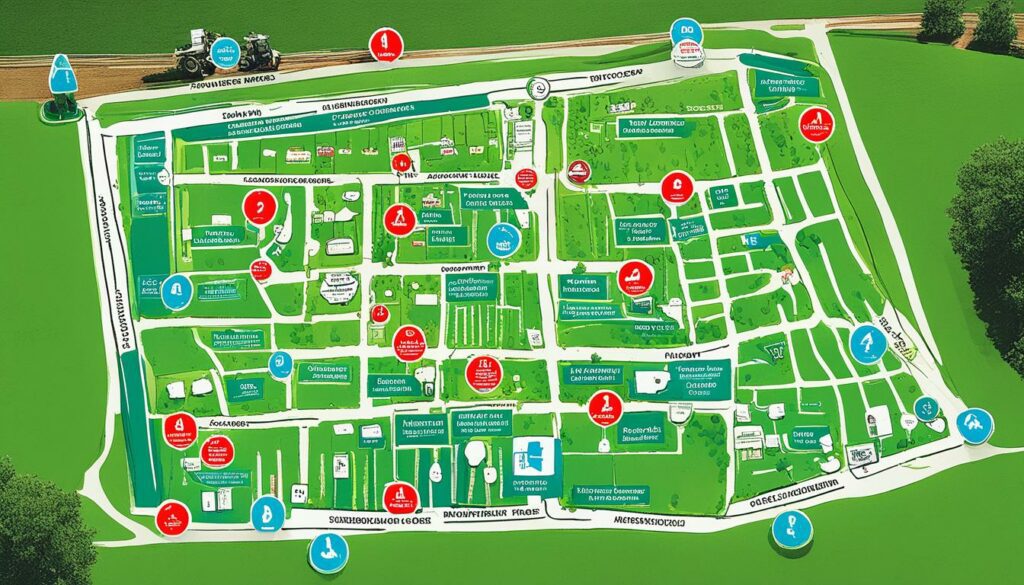
There are key things to include when making a farm disaster plan map:
Highlight every route from most to lesser used. This ensures they’re all well-marked and familiar to everyone. These paths are especially important in places like Minnesota, prone to tornadoes, floods, and fires.
| Preparedness Aspect | Percentage/Frequency |
|---|---|
| Farms with an emergency communication plan in place | 75% |
| Farms with a detailed site map including access routes | 65% |
| Frequency of emergency supply kit preparation among farm owners | 50% |
| Farms with stockpiled emergency supplies | 45% |
| Farm employees trained on the emergency plan | 60% |
A good farm plan includes all important buildings and ways in and out. This makes sure everyone, including emergency teams, knows how to move in a crisis. It also outlines how to watch out for and deal with dangers quickly, keeping everyone safe.
Making a thorough farm inventory list is key. It helps manage the farm’s items and keeps things under control. It’s very important because farming can have sudden challenges. A good list helps plan for crises smoothly.
Start by listing your animals and plants. Note down what types and how many. Keeping a clear record of this data helps act fast if needed. For example, during an emergency, you’ll know exactly what and how much must be saved.
Don’t forget to list all your machines and tools. Include the brand, make, and serial numbers. This detailed information serves many purposes. It makes managing and insuring your tools easier. Plus, it’s crucial for getting things back after a disaster.
| Inventory Category | Details Required |
|---|---|
| Livestock | Species, Number of Animals |
| Crops | Acres, Type |
| Machinery and Equipment | Make, Model #, Serial Numbers |
| Hazardous Substances | Type, Quantity |
An inventory is at the heart of great farm management. It’s also a vital part of a crisis plan. With this list, you can quickly figure out which items need saving first. So, you can act without delay in tough times.
It’s really important to have an emergency contact list on a farm. This list helps manage crises better. It makes quick decisions possible when the main caretaker is not around. Good communication is key in tough situations.
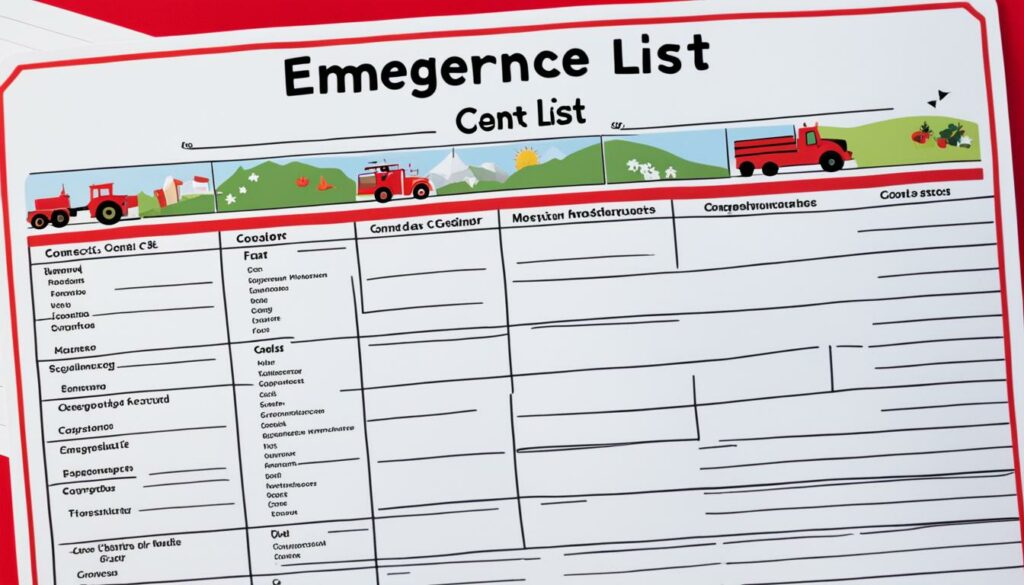
Farms need many different people to help when there’s an emergency. This includes vets, local emergency teams, and suppliers. These contacts ensure smooth crisis help. It’s very important to plan for getting workers and supplies during tough times.
An emergency list should have these key people:
A well-kept list makes getting needed help easier. It helps the farm handle and bounce back from tough times well. Also remember to include escape plans and a meeting spot for everyone in the emergency plan.
Keep your farm’s emergency list up to date. Old contacts can cause problems if not fixed. Regular checks keep your contact info ready for any emergency. This makes your farm’s communication work better during tough times.
| Contact Type | Phone Number | Note |
|---|---|---|
| Veterinarian | (XXX) XXX-XXXX | Specialises in livestock care |
| Local Emergency Management | (XXX) XXX-XXXX | 24/7 availability |
| Insurance Agent | (XXX) XXX-XXXX | For claims and coverage queries |
| Milk Processor | (XXX) XXX-XXXX | Essential for daily operations |
| Feed Supplier | (XXX) XXX-XXXX | Regular delivery updates needed |
It’s essential to make sure your farm’s emergency coverage is enough. Talking to your insurance agent often helps. They can adjust your policies to protect against specific risks in farming.
In places like Minnesota, farmers face tough weather, like tornadoes and floods. A good agricultural insurance review should look into:
These steps help lower the costs and speed up recovery when something bad happens.
It’s key to build a strong connection with your insurance agent for a successful farm emergency coverage. I suggest the following:
Being ready and open with your insurance agent is vital. It’s how you get better protection for your farm.
| Type of Coverage | Example Risks Covered |
|---|---|
| Property Damage | Fire, flood, snowstorm damage |
| Livestock and Crops | Loss due to severe weather |
| Machinery and Equipment | Damage due to natural disasters |
| Liability Coverage | Injuries and accidents on farm |
Keeping an emergency supplies stockpile is vital for every farm. Around 52% of farms have started doing this. They stock up on things like sandbags, plastic sheeting, and fire extinguishers. This helps them be ready for any emergencies.
Farms should keep a well-organised set of important items. This can make a big difference when a disaster strikes. Useful supplies include fire extinguishers, first aid kits, and tools for repairs.
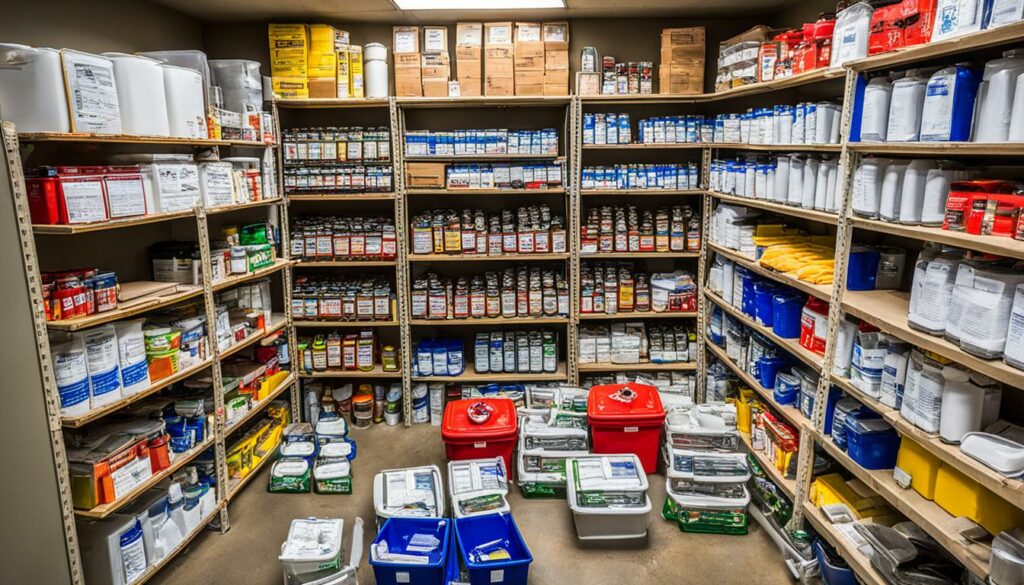
Farms also need to find and protect safe areas for their assets. For example, 32% of farms have found high ground. This helps prevent big losses during emergencies. It shows that these farms are prepared for the worst.
Supplies should be checked and changed every six months. This keeps everything working when it’s needed the most. During big disasters, like Japan in 2011 or Hurricane Maria in Puerto Rico, having supplies ready was key. Waiting for supplies can lead to shortages and make things even harder.
I suggest every farm should have enough supplies for three days for each person. Make sure you have a gallon of water for every person for each day. This should be enough water for drinking and other uses. Make your supplies fit the dangers in your area to be the most prepared.
| Preparedness Measure | Percentage of Farms |
|---|---|
| Emergency supply kit for family | 47% |
| List of emergency phone numbers | 65% |
| Identified higher elevation areas | 32% |
| Stockpiled supplies | 52% |
Only 15% of farms have extra insurance for all types of emergencies. This makes having a good supply of emergency items even more important. It’s the first line of defence for farms against sudden disasters.
Creating plans for emergencies is key to keeping farms safe and running smoothly. These plans include staying where you are or leaving, based on the danger. We will cover all you need to know about getting ready for tough times, which helps keep farms going and protect all life there.
Staying put can be the best choice in some tough situations, like when there’s dangerous weather or chemicals outside. Good shelter-in-place planning means finding safe spots in your buildings for you and your animals. Things to think about include:
Getting these basics ready makes it easier to stay safe and carry on as much as possible.
If you need to get out, it’s crucial to have a clear emergency evacuation plan for farms. Important parts of this plan are:
Let’s focus on important factors for both staying put and leaving safely, turning them into steps you can take:
| Aspect | Sheltering in Place | Evacuation |
|---|---|---|
| Safe Location | Identify and prepare indoor areas | Determine egress routes and safe zones off-farm |
| Livestock Care | Ensure food, water, and ventilation | Plan for transport and temporary housing |
| Resources | Stockpile essential supplies | Maintain backup resources and clear routes |
| Emergency Contacts | Keep a current and accessible list | Update contacts and ensure quick access |
| Labour Management | Train for routine and non-routine tasks | Provide skills training for complex evacuations |
Living and working in the countryside comes with its own set of problems, such as fewer resources and slower help. This is why having these plans is so important. By preparing well for both staying and going in shelter-in-place and evacuation situations, we make our farms and the people that live near them safer.
Being ready for medical emergencies is key on farms. The work on a farm is unpredictable. So, having a plan for when medical issues arise is important. This approach protects both people and animals living on the farm.
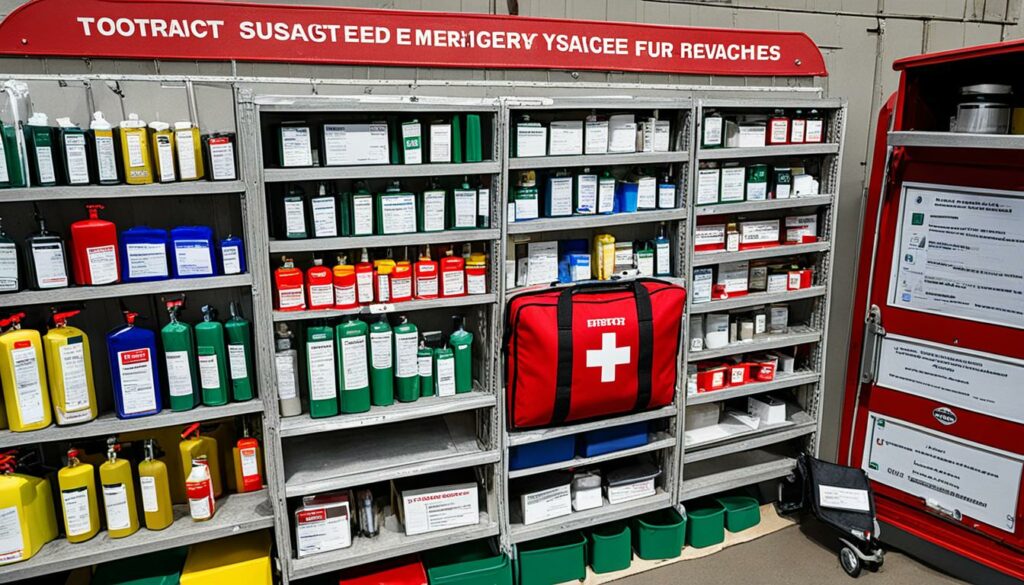
Emergencies on farms can range from heart issues to sudden allergies. Injuries from tools or animals are also common. To handle these, a good emergency plan is needed. This plan should include contact details of local doctors for quick support.
First aid training is crucial for anyone working on a farm. It teaches them how to act in an emergency. For example, they learn CPR and how to help with small injuries. It’s also important for everyone to know if a team member has a health issue.
Having a good first aid kit and practicing drills can make a big difference. Doing this and working with local emergency groups is key. It keeps everyone’s skills and awareness up-to-date.
| Emergency Training | Details |
|---|---|
| Heart Attack Response | Recognising symptoms and performing CPR effectively |
| Allergic Reaction Handling | Using epinephrine injectors and identifying allergens |
| Equipment Injuries | Basic wound dressing and immobilisation techniques |
| Livestock-Related Injuries | Handling bites, kicks, and other trauma efficiently |
These steps make safety more than just a rule on farms. They show a real care for the team’s health. A readiness plan and learning are vital for cutting the effects of sudden health issues.
Dealing with toxic gas and entrapment is key for farm safety. The U.S. Department of Labor’s OSHA oversees safety in narrow spaces. Though farming is not always under these rules, farmers should still follow safety steps. This helps with toxic gas and grain bin safety.
It’s crucial to keep an eye on gas levels, especially in manure areas. Renting gas detectors at $180 a day or $360 a week is smart. These tools check for air quality and dangerous gases. Following advice on proper ventilation can lower the chance of breathing problems or gas exposure.
When there’s an emergency, it’s vital to have skilled people and the right gear ready. If there’s a gas leak or someone is trapped, calling for help fast is essential. Farms should have at least two people trained in first aid. This is to handle urgent medical cases from such events.
| Emergency Type | Recommended Action | Relevant Equipment |
|---|---|---|
| Toxic Gas Release | Monitor gas levels, evacuate, contact rescue services | Gas detectors, ventilators |
| Grain Bin Entrapment | Avoid entry, contact rescue services, use harness | Harnesses, ventilation equipment |
| Silo Rescue | Lift victim from the surface, use self-contained breathing equipment | SCBA, backboard, body sling |
For grain bin incidents, quick action and the right tools are crucial. This includes harnesses and not risking your safety to save others. Doing this the right way cuts danger, protecting life and farm assets.
Manure areas can seem safe sometimes, but sticking to safety steps is wise. Keep these steps up to date for when emergencies happen. This is vital for being fully prepared in farming.
A crisis communication plan for farms is key for fast and effective response in emergencies. Good communication helps lessen the crisis’s impact on the farm and keeps stakeholders trusting. By using local resources and community networks, these plans become stronger. This keeps everyone well-informed and ready.
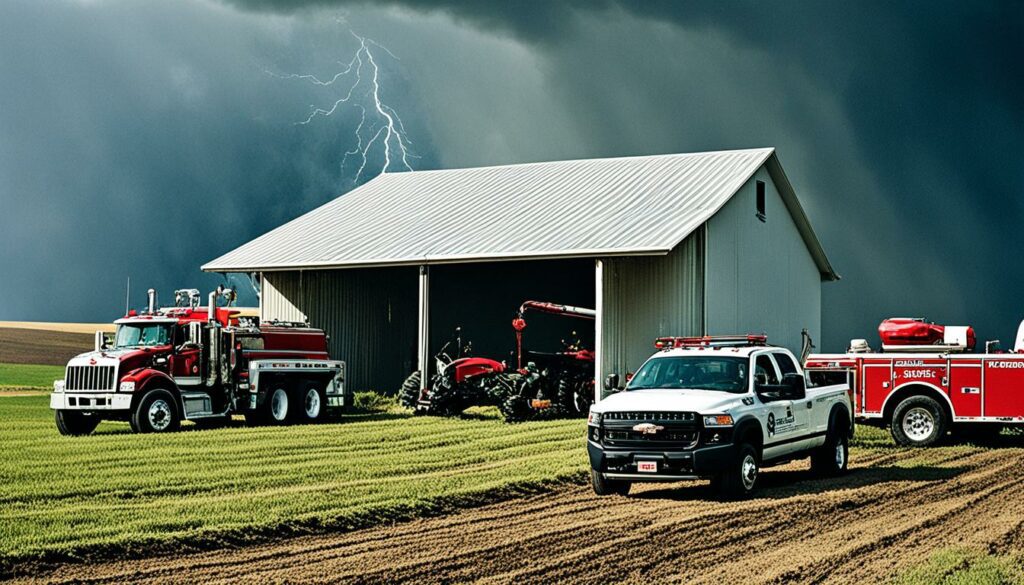
Getting local emergency services on board is essential for a working crisis communication plan for farms. These include fire departments, police, and medical teams. They help in crises from natural disasters to health issues. Working closely with them means they know the farm well, leading to better and faster help.
Community alert systems are a must in a crisis communication plan for farms. They spread critical info quickly to the farming community and its neighbours. This makes sure everyone knows what’s happening in a crisis.
These systems can be set up for different emergencies, like natural disasters or health scares. Putting them in the farm’s plan means people get the right info fast. This also helps build a strong farm image and community support.
Making a crisis communication plan for farms work well needs working with local emergency services and using community alert systems. With these parts in place, farms can prepare for, respond to, and bounce back from crises. This keeps farms safe and the community strong.
Emergencies on farms need fast and accurate communication. Agricultural technology helps a lot in these situations. It’s not just useful; it’s critical for farmers.
Rural areas often have fewer resources than urban ones. This includes limited equipment, money, and technical support. These challenges make it hard for rural hospitals and emergency professionals to react quickly when needed.
Local, state, and federal agencies might find it hard to work together in the countryside. This is often because many rural residents are elderly, have disabilities, or are low-income. The lack of good communication and warning systems makes things even harder.
The lack of broadband is a big issue in rural areas too. The FCC says more than 18 million Americans can’t get fast internet. This is due to both the lack of service and its high cost.
To improve, we need to upgrade our communication tech. We should use things like ad hoc wireless systems in places with no broadband. Having backups and doing regular maintenance is also key to reducing emergencies.
Agricultural tech in emergencies goes beyond just internet access. It includes smart safety systems that can track a farmer’s health and call for help. GPS tech and special apps can help locate someone needing aid accurately.
New tech makes it much easier to send out warnings quickly during emergencies. This can save lives and protect farms. Using alert systems and special software is crucial for managing crises well.
Emergency preparedness is key in farming due to the high risk of fatal accidents. It’s vital that workers can handle emergencies well. A programme with practice drills and simulations greatly boosts emergency response quality.
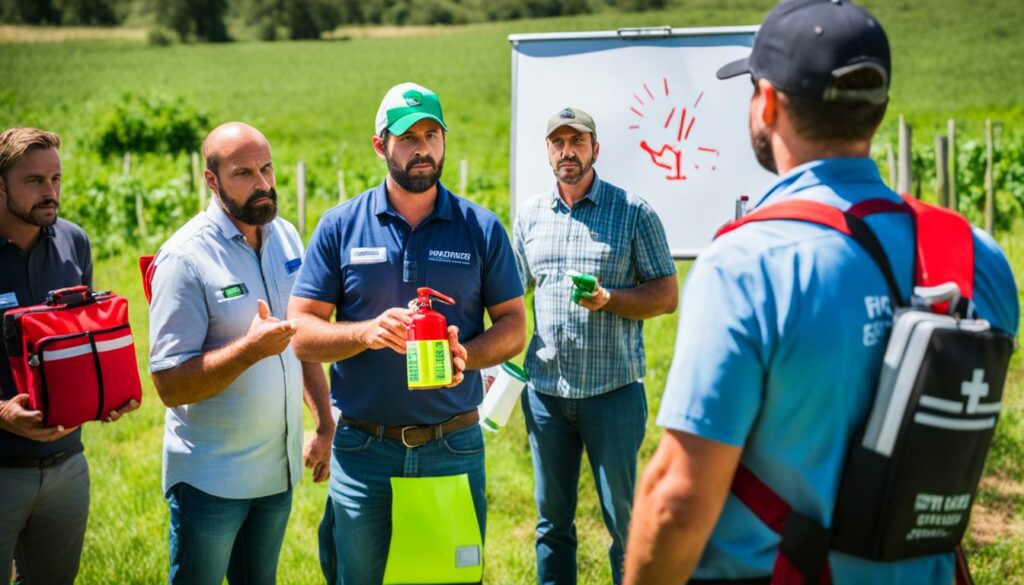
Emergency protocol training keeps farm workers hands-on and ready. Realistic simulations, like tractor accidents or gas leaks, teach them to avoid danger. This way, everyone learns the right steps to stay safe, creating a safety-minded culture.
Teaching and updating workers constantly is crucial for top-notch emergency readiness. Regular sessions ensure they know the latest and remember the basics. Detailed records of training help spot areas for improvement. It’s important to document who’s attended, what they’ve learned, and how they did in farming emergency simulations. This thorough approach makes sure everyone is prepared.
Coordinating with local authorities is key for a farm’s emergency plan. It’s important to have emergency contact info handy. Also, keeping in touch regularly with updates helps a lot in a crisis.
It’s crucial to have a complete list of emergency contacts. This includes local fire and police, and ambulance numbers. This local authority collaboration in farm emergencies ensures quick help when it’s most needed. Don’t forget to update contacts for groups like the American Red Cross and the Salvation Army. They provide crucial help after a disaster.
Talking often with local authorities makes emergency response smoother. This means having regular meetings with them and joining community discussions. These talks are important. They help tackle problems in rural areas, especially for those who are isolated or at risk.
| Impact of Natural Disasters | Safety Measures |
|---|---|
| Disease from dirty water (e.g., Cryptosporidium, Giardia) can hurt people. | Talk with local emergency services to find and stop risks. |
| Carbon monoxide poisoning can happen if fuel isn’t used right. | Teach how to use fuel safely and check often during outages. |
| Mold from floods can make sick people with asthma or weak immune systems. | Keep in touch with health departments for quick advice and help. |
Natural disasters hit hard, especially in rural places. These can worsen poor living conditions and hit industries. By working closely with emergency services networking, communities are better prepared. They can act fast and recover well. Plus, supporting mental health boosts the strength of these areas against disasters.
In farm emergency management, a good communication network is vital. It makes sure everyone knows what’s happening and can act fast when needed. Both old and new media are key to making this work.
The traditional phone tree method is still very effective on farms. It ensures all important information gets to everyone quickly. This leads to a response that is well-planned and coordinated. Also, using radios and similar devices can help if mobile phones don’t work.
This technology sets up a clear leadership chain. This means tasks are done correctly and on time. Regular drills make sure the team is ready for whatever comes.
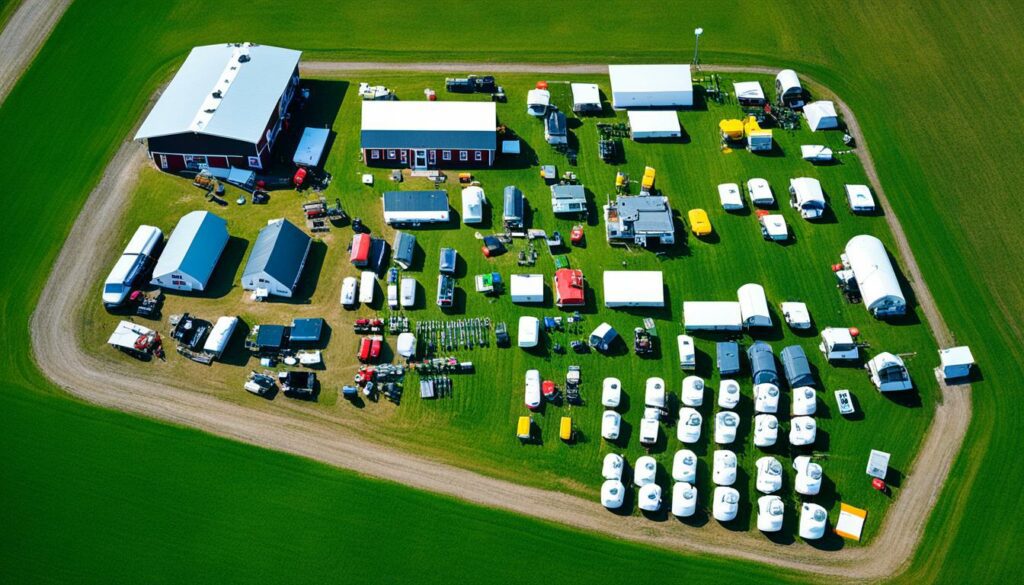
Social media is key for crisis management today. Sites like Facebook and Twitter are fast at sharing news. They reach loads of people quickly, helping to spread essential updates. This makes real-time communication possible, which is crucial in emergencies.
Farmers can also use social media to connect with local groups and emergency services. This keeps them up to date with what’s happening. It helps to work with others better. Social media also fights false news by sharing the right information. This helps everyone make wise choices during tough times.
Using all these tools helps set up a strong farm communication network. It makes emergency responses quick, accurate, and successful.
It’s vital to often review your emergency plan on the farm. This keeps your preparedness sharp because disasters can hit suddenly. So, always tweak and improve your emergency protocols.
A good communication plan is a must for farms. It makes sure everyone knows what to do fast in a crisis. Also, checking your supplies often can help you stay ready for any trouble.
It’s smart for farmers to review their insurance yearly. This makes them better at controlling risks and offers financial safety. Don’t forget to keep track of all your tools and equipment. It helps with daily work and in an emergency.
Know and work with other farm experts. They can be a big help in hard times. Sharing knowledge and following the best practices makes your farm ready for any sudden issue.
Keep your emergency plans up-to-date. This way, you’re always ready for whatever comes. Regular updates make your plans strong and ready to face new dangers.
To create a strong farm emergency plan, being ready, flexible, and keeping up with new tech are key. For instance, the wildfires in Texas, Oklahoma, and Kansas in the late 2010s were devastating. They caused seven deaths and ruined millions of acres of land. It shows why we need plans to deal with such big disasters.
Wildfires on the High Plains increased by 400% between 1984 and 2014. In 2016, 2017, and 2018 alone, almost two million acres were hit. These numbers tell us how important a well-thought-out emergency plan is. Experts advise making ways for people to help out and talking about how to handle crisis situations. They even suggest teaching about crisis communications at school.
Big fires like the Anderson Creek Fire and the Starbuck Fire show how tough it can be. It’s vital to have a good farm emergency plan and strong ways to talk to others. This means always training and working with local groups. And, using the latest tech. This is the best way to make sure farms can save both lives and work when bad things happen.
A good strategy has a detailed map and inventory. It also includes an up-to-date contact list and insurance checks. Plus, it has ongoing training for farm staff.
Life on a farm can be risky, with threats like severe weather and fires. An emergency plan helps everyone know what to do quickly, protecting both people and property.
It should show all farm features and dangers like chemicals. It helps emergency teams navigate and respond effectively.
List all your animals, crops, and equipment. Include serial numbers and hazardous materials. This helps in emergencies and with insurance claims.
Key contacts are vets, emergency services, and insurers. Don’t forget suppliers like feed companies too.
Critical coverages include buildings, livestock, and machinery. Also look at general liabilities to make sure everything is protected.
Always have tools, first aid, and ways to fight fires. These essentials are vital during disasters.
Each scenario needs a specific plan. Include how to stay safe or leave the farm. Make sure to handle hazardous materials safely.
Medical issues like heart problems and injuries can happen. Train staff in first aid and keep emergency contacts up to date.
For events like gas leaks or someone getting stuck, have response plans. Ensure everyone knows what to do and how to stay safe.
Include local services and alert systems in your plan. Communicate quickly and clearly when there’s an emergency.
Use emergency tech like alerts and apps for better communication. They can be life-saving during crises.
Training workers and running drills improves how they react to emergencies. It helps keep everyone safe and the farm running smoothly.
Share contact details and keep in touch with local services. Working together is key for a coordinated emergency response.
Set up calling plans and use radios for easy communication. Also, social media can update everyone quickly when needed.
Looking at emergency plans often adds new safety measures and ensures they still work well. This protects the farm and everyone on it.